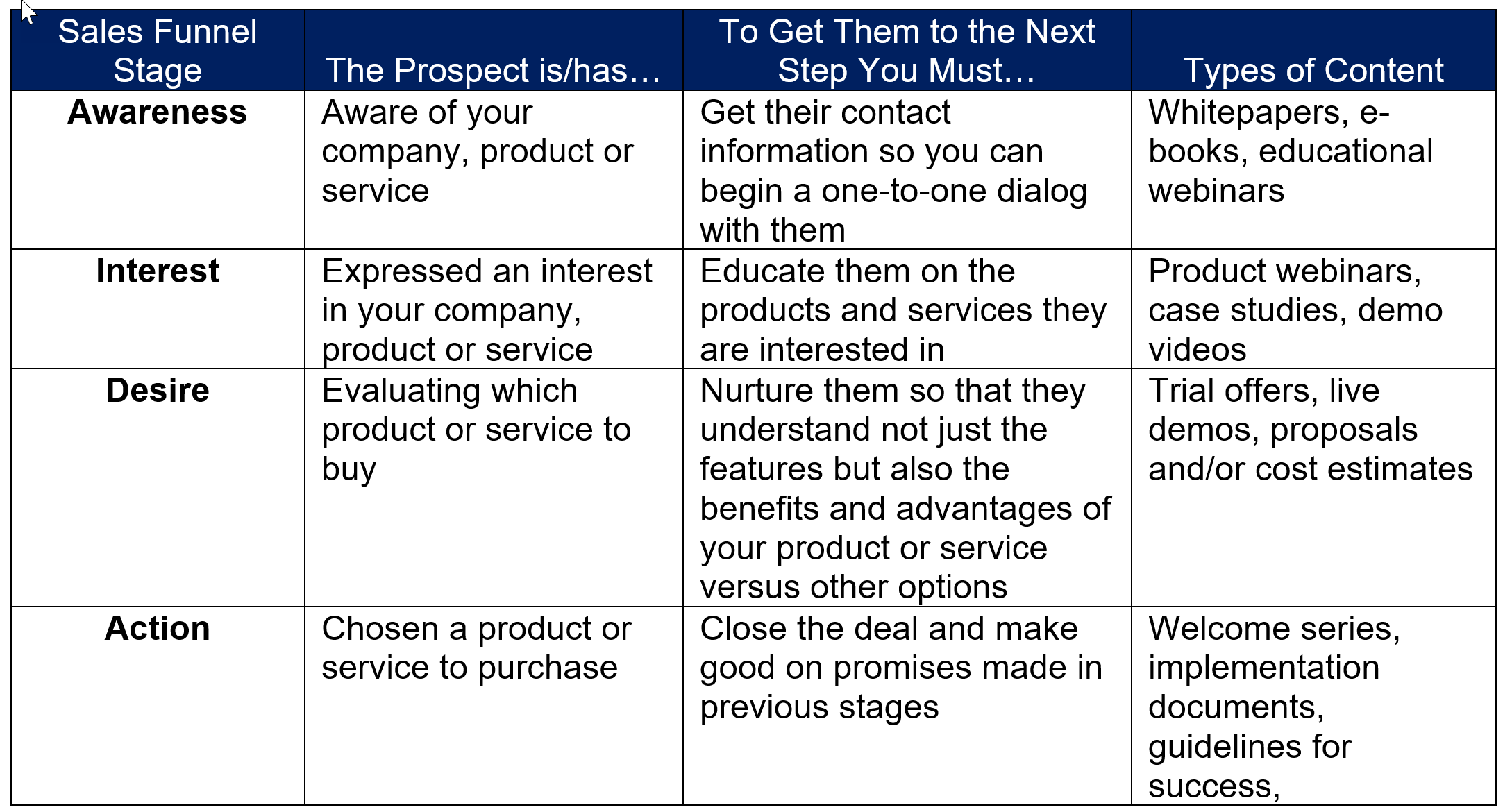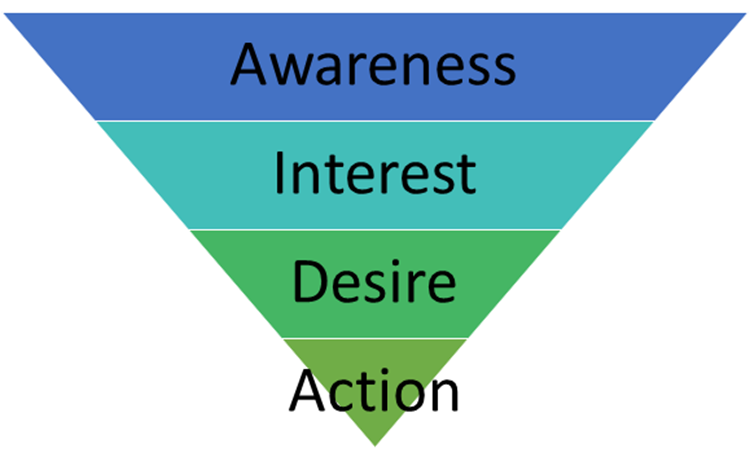A sales funnel, also sometimes referred to as a purchase or revenue funnel, is a consumer-focused marketing model which maps out the theoretical journey a customer takes towards the purchase of a product or service.
While the definitions for sales funnels often uses the word "consumer," sales funnels are used in both the business-to-business (B2B) and business-to-consumer (B2C) realms. The sales funnel takes on its shape because the quantity of prospects moving from one stage to the next (from the top to the bottom) becomes increasingly smaller. The most commonly used sales funnel has four stages: Awareness, Interest, Desire and Action. These stages are often referred to as AIDA.
Although this is the most common sales funnel used, some organizations customize the steps and stages of their sales funnel to create something that suits their business.
No matter what your sales funnel looks like, it’s important to understand:
- the prospect’s disposition at each stage
- what you need them to do to progress to the next stage
- what type of content you should provide to get them there
Here’s a quick rundown, with more detail on each stage after the table.

Awareness
At this stage, the prospect is likely researching a problem or need that they have, or think they might have. If your product or service solves that problem or addresses that need, you want to make the prospect aware of your company and your offering(s) and begin a one-to-one dialog with them.
One way to make people aware of your business is to publish the editorial, meaning not sales-like, information related to the problems or needs of your prospects that are free for anyone to read. You can do this via your blog, like the Pinpointe blog, or via third-party sites (blogs or online publications) that accept content from outside contributors.
In this case, content usually consists of articles or blog posts; most publications are looking for items between 500 and 1,500 words. It should be optimized for search engines so that it will show up in results if a person is looking for information on a related keyword.
This use of content is perfect for getting the word out about your company – but there’s a next step that you need to move prospects to the next stage of the sales funnel—you need their email address.
People value their email address – so if you want them to share it with you, you need to offer them something of equal or greater value in return. Some forms of content in this exchange include:
For example, I have a number of clients who offer free whitepapers in return for a prospect’s email address. I have a few clients who host educational webinars and require people to provide an email address to register for them.
The best incentives to offer in return for an email address are not strictly about selling. Remember: these people aren’t ready to buy yet. They are still in research mode. So offer them something to allow them to increase their knowledge, not something that is only useful to them if they’ve already settled on buying your product or service.
Interest
At this stage, the prospect is interested in your company, product and/or service, but they aren’t yet ready to speak to a sales person. Your goal is to get them there by continuing the education process and adding in information on your products and services.
Content to consider at this stage includes:
- Product webinars
- Case studies
- Demo videos
This is also where you can start scoring leads and identify actions that hasten their move to the next stage of the sales funnel.
For instance, I have a client who offers free product webinars at this stage. They’ve found that people who attend these webinars are six times more likely to purchase than those who don’t attend. So a key goal for them at this stage is to get people to attend those webinars. Their messaging at this point doesn’t push for the sale – it pushes for webinar registration and attendance since they know that if they get prospects to the webinar, the sale is very likely to follow.
Desire
At this stage, the prospect has decided to purchase – they are just determining which company to purchase from. This is the place where you want the lead to start communicating directly with your sales team if you have one.
Email communication in this stage should be used to (a) entice the prospect to speak to the sales team and (b) help the sales team respond effectively and efficiently to questions and concerns raised by the prospect.
To this end, content tends to consist of:
- Product or service trial offers
- Product or service demonstrations
- Proposals and/or cost estimates
I have a client who, at this stage, offers prospects a $25 gift card for sitting through a product demonstration. Another company in my area routinely offers prospects a free lunch, during which a sale rep pitches their product line. Offering these types of incentives along with the promotional content can be a great way to get prospects who are on the fence to engage with your sales team and help drive revenue.
Action
At this stage, the prospect is ready to buy your product and, once they do, you will want to support that purchase with content. Your goal here is to maintain the positive feelings the client had before the sale – and perhaps to get them to refer their friends and colleagues to your company.
Typical types of content used here include:
- Welcome emails
- Implementation documents
- Guidelines for success
Many of my clients have a ‘welcome’ series of emails which detail the implementation process or introduce the new customer to the features of their purchase. It’s a good idea to also include some ‘motivational’ content to keep the customer excited about their purchase and help them overcome any ‘bumps’ that may occur while they get up and running with your product.
And don't forget about referrals! Once the customer is up and running, it's a great time to ask for a customer testimonial. You can use testimonials in your marketing and to refer your company to their colleagues.
Closing
The sales funnel concept is a valuable one for anyone doing business. Matching it with content specific to each stage of the funnel is a way to make your sales process more effective and more efficient. Test out these ideas with your sales process and let me know how it goes!
[Tweet “The Best Content for Each Stage of Your Sales Funnel”]








